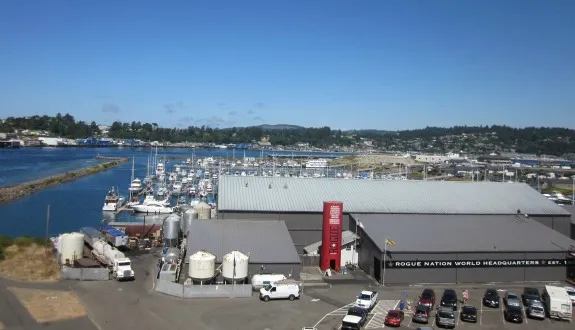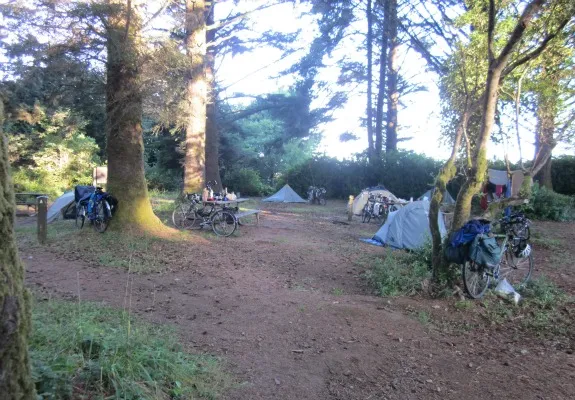At a Glance: The Good, the Bad and the Ugly of the Oregon Coast
The coastal Highway 101 route, through rainforest and redwoods, is as beautiful as it is popular
/https://tf-cmsv2-smithsonianmag-media.s3.amazonaws.com/filer/20120829011059OregonSunsetSMALL.png)
Between Portland and San Francisco lie thousands of miles of zigzagging routes across a complete spectrum of landscapes. To get home to San Francisco, I considered traveling east and south over the high desert and scrub country of Oregon’s Deschutes, Lake and Harney counties and from there into California’s volcanic northeast. I also gave thought to weaving my way south through the Cascades. Another option was to travel the length of the Willamette Valley, home to much of Oregon’s wine country, then over the high plains around Ashland and Weed and south further, past Mount Shasta, and into the Sacramento Valley. But I succumbed to the allure of the obvious: the coastal Highway 101 route, through rainforest and redwoods, and as beautiful as it is popular. I camped a night at Willamette Mission State Park for the standard $5 bicycle fee, had a quick peek at the college town of Corvallis, pedaled over the coastal mountain range via Highway 20, slept in the Eddyville pasture of a Baptist family who sent me off with a prayer in the morning, and then hit the famous coast where the ride began. Here are the highlights—good, bad and ugly.
Newport. John Maier rides his bicycle across the Yaquina Bay Bridge almost every morning. Some days he turns right at the south end to hunt porcini mushrooms among the pine trees on the sand dunes. At least once, he rode all the way to the California border during the annual Amgen People’s Coast Classic, a charity ride against arthritis. But most days, Maier turns left and rolls down into the parking lot of Rogue Ales‘ headquarters, where he has been brewing the well-known beers since 1989. Rogue is a pillar of the community in Newport—possibly the finest, coolest community on the Oregon coast. Rogue has a brewpub on the north side of the bay, on the thriving, colorful wharf, while the main brewery and a distillery operate in South Beach. Every local is familiar with the brewery, and Rogue’s presence seems as deep and permanent as the salty wind that sweeps in off the Pacific. Last year, when a local surfer named Bobby Gumm was attacked by a great white shark just outside the harbor, it was Rogue that stepped forward and replaced the uninjured man’s board, from which the shark had taken a trophy-sized bite. Other locals know the brewery simply for its beer, which can be as quirky and eccentric as the funky, artsy, salty town itself. Maier makes a regular beer brewed with chipotle peppers and recently produced a batch infused with bacon. A beer tried once but abandoned was made with garlic, and another one-off was a cilantro ale. Visitors to Newport can’t—and shouldn’t—miss this brewery, whose warehouse stature and giant beer silos are easily seen from the bridge as one travels south. Staple beers are the Dead Guy Ale, the Old Crustacean Barleywine, the Shakespeare Stout and an ever-evolving line of IPAs made with unusual hop varieties. As Maier said to me during a quick pint together at the South Beach pub, “Label something an IPA, and people will buy it.” So prove him wrong and order the Double Chocolate Stout.

Coos Bay and North Bend. Coos Bay greets a southbound touring cyclist with a rude sneer: the Conde B. McCullough Bridge. Narrow, long, gusty and busy with lumber trucks and autos, the bridge should be crossed on the sidewalk unless you don’t care to live to see the town, which would be understandable. Coos Bay has a reputation as an indifferent old mill town, rough and salty, with a calloused, blue-collar populace marginally interested in welcoming tourists. And it isn’t hip, cool or edgy like Newport. But accept the steely gray of the bay-side machinery and paper mill, and look a bit further, you’ll find some charm. Just after the bridge, a right turn lands you in a picnic park and playground, complete with all the basics of a much-needed rest stop, like soft green grass, tall trees for shade, pullup bars and barbecue grills. Further into town, along Broadway Avenue, are a movie theater, antique shops, a yarn store for locals to knit their fishing beanies and winter mittens, coffee shops, a sushi restaurant, a fantastic, shadowy, dust-layered wine cellar and a grim-looking gun store. But best of all is the Coos Head Food Co-Op on the west side of the street, an essential stopoff point for southbound cyclists running low on rations of nutritional yeast, $3 avocados and wheat germ. Indeed, I will grant that Coos Bay was good to me; its quaint Americana charm feels poignantly delightful, like a gritty scene from American Graffiti. But it grew old after a few blocks, and by the time I reached end of the main strip, I only wanted out of this town. Perfect, because by then Coos Bay was behind me as I rode the never-ending, screaming tailwind south.
Gold Beach. “Welcome to Gold Beach,” reads the sign as one crosses the bridge over the Rogue River and enters this thriving little hub of resorts and outdoors gear shops. But Gold Beach is the town that the Kim family of San Francisco never reached on November 25, 2006, when they started on a midnight drive west across the coastal mountains from Grants Pass and got snowbound in the high country of the Rogue River-Siskiyou National Forest. James Kim, 35, made a heroic attempt to seek help for his family and walked for days downstream, though he didn’t get far. After his wife and two daughters were rescued, Kim’s body was eventually found just a mile as the crow flies from the car. He was also only a mile from the Black Bar Lodge, which was closed at the time but full of food and supplies. I considered pedaling up the small highway that leads into the rugged terrain that Kim attempted to traverse in the dead of winter, on foot, but I thought better of the plan after speaking with a local man outside a grocery store. He said, ”Bring plenty of water and food. But if you want a real adventure, it’s a great area to go.” The wind was howling southward, and the path of least resistance was, well, irresistible; I flew south 25 miles with almost no effort, arriving at Harris Beach State Park campground after dark.
It was at this campsite, just north of Brookings, that I met, among a dozen other cycle tourists, a lanky vegetarian hippie named Tim with dreadlocks down to his waist and riding a rusty single-speed bike with two purse-sized saddlebags on the rear. He told me his next immediate destination was Ashland, Oregon—an uphill, inland ride of more than 100 miles from Crescent City on Highway 199. Tim explained that Ashland, a known hippie hotspot and counterculture destination, is home to one of the most abundant, glorious natural foods grocery stores in the West. I was tempted and even went away to study my map before I came to my senses: I reasoned that granola, coconut oil soaps and bulk bins of sprouted grains could be found almost anywhere; 300-foot-tall redwoods cannot. I continued south, along the California North Coast. Stay tuned for more.
Other Oregon Coast highlights: Oceana Natural Foods Cooperative in Newport; Bike Newport Oregon in Newport, a shop that caters to cycle tourists with a lounge, sofas, showers, Internet access and a foosball table; Bullards Beach State Park campground, where mushroom hunting is legal in season; Mother’s Natural Grocery in Bandon by the Se; Oregon Wine Cellars Etc in Coos Bay; entertaining anti-Obama political banners posted along the road; Wednesday and Saturday farmers market in Brookings; migrating whales visible from shore for those who take the time to stop; bottomless bounties of enormous roadside blackberries; a northwind that virtually never stops (read as, ”Don’t try pedaling San Diego to Seattle”).

/https://tf-cmsv2-smithsonianmag-media.s3.amazonaws.com/accounts/headshot/Off-Road-alastair-bland-240.jpg)
/https://tf-cmsv2-smithsonianmag-media.s3.amazonaws.com/accounts/headshot/Off-Road-alastair-bland-240.jpg)